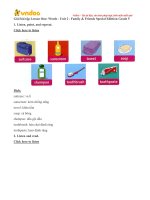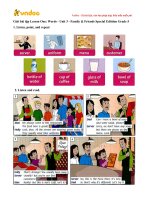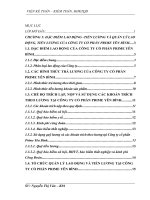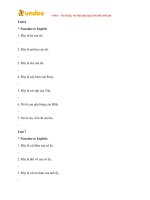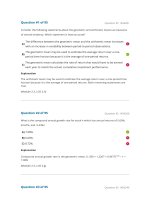Macmillan natural and social science prime 1
Bạn đang xem bản rút gọn của tài liệu. Xem và tải ngay bản đầy đủ của tài liệu tại đây (1.42 MB, 12 trang )
Contents
Level 1
Content
Let’s investigate!
All about me
• Physical characteristics
• My eyes
• My hair
Unit 1
•
•
•
•
•
•
•
Places in the school
People at school
The classroom
Good behaviour
What we do at school
School subjects
In the playground
• What’s in your classroom?
•
•
•
•
•
•
•
The picnic
The five senses
I can hear
I can taste
I can touch
I can see
My senses help me
• What’s in the pots?
Smell and find out!
•
•
•
•
•
•
•
I can move
My body
My joints
My face
Feelings
Staying healthy
Growing up
• Can you move with no joints?
•
•
•
•
•
•
•
Family members
My family
Helping at home
Families are different
Where do you live?
The parts of a house
Rooms in a house
• Do you help at home?
•
•
•
•
•
•
•
At the market
Fruit and vegetables
Healthy food
Food that’s good for me
Food from plants and animals
My meals
Healthy habits
• Where do eggs come from?
•
•
•
•
•
•
•
Domestic animals
Animal babies
Wild animals
Animal habitats
Animals are different
How do animals move?
Living and non-living things
• What animals are around
your school?
My school
Unit 2
My senses
Unit 3
My body
Unit 4
My family
Unit 5
Food
Unit 6
Animals
Content
Unit 7
Plants
Unit 8
Water and air
Unit 9
My neighbourhood
Unit 10
Landscapes
Unit 11
The Sun
Unit 12
Materials
Let’s investigate!
•
•
•
•
•
•
In the garden
What plants need
Parts of a plant
Plants in my environment
We eat different parts of plants
The life cycle of a plant
• How do plants grow?
• How do plants take in water?
•
•
•
•
•
•
•
Water is everywhere
All living things need water
Uses of water
Air
Wind
The weather
What’s the weather like?
• What’s water like?
•
•
•
•
•
•
Places
Places in my neighbourhood
People who help us
Where do you live?
Transport
Road safety
• What do you want to be?
• What’s near your school?
•
•
•
•
•
•
Inland and coast
Inland and coastal landscapes
The island
Natural and man-made features of landscapes
Coastal animals
Safety at the coast
• Is Spain an island?
• Has Spain got any islands?
• What natural and man-made
features are near your school?
• Is sea water salty?
•
•
•
•
•
•
What’s in the sky?
Day and night
Nocturnal animals
Protect yourself in the Sun!
The seasons
The calendar
•
•
•
•
•
•
•
•
•
•
•
In the kitchen
What things are made of
Is it waterproof?
Properties of materials
Transparent and opaque materials
Objects made from more than one material
Let’s recycle!
• Is it waterproof?
• Which materials float and
which materials sink?
What is the Sun?
What shape is the Sun?
Why do we need the Sun?
Why do we have day and night?
Contents
Level 2
Content
Let’s investigate!
What we already
know
• What do you remember?
Unit 1
•
•
•
•
•
•
•
My joints
Our three body parts
My skeleton
Muscles
Internal organs
My senses
What we can do with our senses
• What are bones like?
• Investigate muscles
• Does your heart beat faster when
you exercise?
•
•
•
•
•
•
•
•
The shopping list
Food groups
Health, growth and energy
A healthy meal
Five a day
Stay healthy!
Making bread
Wheat, eggs and milk
• Do you have balanced meals?
•
•
•
•
•
•
•
In the grasslands
Animal habitats
What do animals eat?
Which animals are mammals?
All about mammals
Birds
Bird or mammal?
• Which animals are herbivores,
carnivores or omnivores?
•
•
•
•
•
•
•
•
Animals that lay eggs
Vertebrates and invertebrates
Reptiles
Amphibians
Insects
Invertebrates
Fish
Let’s classify animals!
• What’s the life cycle of a frog like?
• Investigate invertebrates that live
around your school
• What is a fish’s body like?
• How do fish breathe?
• How do fish move?
•
•
•
•
•
•
•
Plants and animals
Parts of a plant
Plants need soil
Trees
Evergreen and deciduous trees
Seeds
Life cycle of a plant
• Do plants need soil to grow well?
• Do plants need warmth to start to
grow?
• Which fruits have only one seed?
Which have many seeds?
•
•
•
•
•
•
Water
The three forms of water
The water cycle
Water and land
Look after the environment!
All about air
• Does water change?
• Can you make a water cycle?
• What can you move with air?
The human
body
Unit 2
Food
Unit 3
Animals
Unit 4
More animals
Unit 5
Plant life
Unit 6
Water, land
and air
Content
Unit 7
The Sun
Unit 8
The city
Unit 9
Materials
Unit 10
Forces
Unit 11
Electricity
Unit 12
Time
Let’s investigate!
•
•
•
•
•
•
•
The planetarium
The Sun, the Earth and the moon
The moon
Day and night
Sunrise, midday, sunset
Why do we have seasons?
All about the seasons
• Does the moon really change shape?
• Investigate day and night
•
•
•
•
•
•
•
Buildings
Public and private buildings
Transport
Road safety
Safety rules
Cities and villages
People who help us
• Do some roads have more traffic?
•
•
•
•
•
•
•
The new house
Materials and their properties
Properties of materials
Magnetism
Bend, twist, stretch, squash
Natural and manufactured materials
Heating and cooling materials
• Which objects are magnetic?
• Investigate bending, twisting,
stretching and squashing materials
• Investigate materials and temperature
• Investigate ice and warmth
•
•
•
•
•
Push and pull
How forces affect speed and direction
Sources of light
Shadows
Sources of sound
• How do forces affect objects?
• Investigate blowing the ball
• Investigate how sound travels
•
•
•
•
•
•
•
Plug it in!
Electrical appliances
Electricity is dangerous!
Save energy
Mains or batteries?
Machines
Simple and complex machines
• Investigate simple machines
•
•
•
•
•
•
•
The museum
Measuring time
Max’s busy day
Timelines
In the past
Communication
Transport in the past
• What was the city like in the past?
• Can you make a timeline?
Contents
Level 2
Content
Let’s investigate!
Welcome to the Science Club
Unit 1
Living things
Unit 2
The senses
Unit 3
We can move
Unit 4
Animals
Unit 1–4
Review
Unit 5
Plants
Unit 6
Habitats
• Identifying living things
• Life processes of living things
• Life processes: People
• Life processes: Animals
• Reading: The rock pool
• Writing: Living and non-living
things near me
• How do plants interact?
•
•
•
•
•
How we use our senses
We can see
We can hear
We can smell
We can taste
•
•
•
•
We can touch
The nervous system
Reading: A visit to the optician’s
Writing: How I use my
senses
• How does the eye work?
•
•
•
•
•
How we move our body
Bones: The skeleton
Bones: Different types of bones
What bones are made of
Joints
•
•
•
•
Muscles
The muscles in our body
Reading: The P.E. class
Writing: What my body needs
• What happens if our
bones don’t have
enough calcium?
•
•
•
•
Classifying animals
Vertebrates
Invertebrates
How animals reproduce
•
•
•
•
What do animals eat?
Animal coverings
Reading: Animals in danger
Writing: Animals in danger
• What do you know
about insects?
•
•
•
•
The life cycle of a plant
We need plants
Reading: A special plant
Writing: My favourite tree
• What types of leaves are
there where you live?
• Do seeds need soil to
germinate?
• Science Club Quiz
• Science Challenge
•
•
•
•
•
Classifying plants
Parts of plants
Plants around us
Identifying leaves
Flowers
• Where living things live
• The Arctic region and
savannahs
• Deserts, tropical rainforests
and temperate forests
• Water habitats
• Interaction in ecosystems
• The food chain
• Reading: A surprise under the
sea
• Writing: Protecting ecosystems
• How does the food
chain work?
Content
Unit 7
Let’s investigate!
•
•
•
•
•
Where we find water
Characteristics of air
Wind
Weather
Freshwater
• The water cycle
• Reading: The drought
• Writing: How I use and save
water
• Does air have weight?
• What’s the wind speed,
rainfall and temperature
where you are?
Landscapes
•
•
•
•
•
Different landscapes
Mountain landscapes
Flat landscapes
Relief maps
Rivers
•
•
•
•
•
• Can you make a relief
map?
Unit 5–8
• Science Club Quiz
• Science Challenge
Water and air
on Earth
Unit 8
Review
Unit 9
The top layer
of Earth
Unit 10
Transport and
communication
Unit 11
Work
Unit12
Where we live
Unit 9–12
Review
Coastal landscapes
Coastal landscapes change
Protecting coastal landscapes
Reading: A trip down the river
Writing: My local area
•
•
•
•
Soil
Soil layers
Types of soil
The soil ecosystem
• Rocks and minerals
• Reading: An amazing discovery
• Writing: The soil where I live
• How do soil layers form?
•
•
•
•
•
•
Transport
Land transport
Air and sea transport
Private and public transport
Personal communication
Mass communication
•
•
•
•
• What’s the most common
form of transport in your
class?
• Do advertisements work?
• The three job sectors
• Primary sector: Arable
farming
• Primary sector: Livestock
farming
• Natural resources from
the sea
• Natural resources from
the Earth
•
•
•
•
•
•
Places
Places change
Services in a city
Maps
Reading: Lost!
Writing: Where I live
• Science Club Quiz
• Science Challenge
Computers and the internet
Advertisements
Reading: The Science Club blog
Writing: My transport for the
future
• Secondary sector: Craft and
industry
• Tertiary sector: Providing a
service
• Reading: The Science Club
volunteers
• Writing: A job description
• Which job sector do
most of your classmates’
families work in?
• How can you help
people find places in
your school?
Contents
Level 4
Content
Let’s investigate!
What we already know
Unit 1
•
•
•
•
•
•
•
•
Classifying food
Nutrients
A healthy, balanced diet
The digestive system
Teeth
The excretory system
Reading: Happy Birthday, Professor Eco!
Writing: What did you eat yesterday?
• How does the digestive system work?
•
•
•
•
•
•
•
Growing up
The circulatory system and the heart
The respiratory system and the lungs
The reproductive system
How we’re born
Reading: Yousef’s surprise
Writing: Growing up
• How does the heart work?
• How do we breathe?
•
•
•
•
•
•
•
Mammals
Birds
Fish and amphibians
Invertebrates
Reptiles
Reading: The invertebrates hunt!
Writing: Animals in my environment
• Which animals live near you?
Plants around us
Pollination and fertilisation
How plants make their own food
Reading: The beehives
Writing: Pollination
• How does photosynthesis work?
Plants
•
•
•
•
•
Units 1–4
• Science Club Quiz
• Science Challenge
Food and
nutrition
Unit 2
Our body
Unit 3
Animals
Unit 4
Review
Unit 5
Our planet
Unit 6
Energy
•
•
•
•
•
•
•
•
The solar system
The Earth’s moon
The Earth’s rotation and orbit
Our planet
The Earth’s year
Climate on Earth
Reading: The solar eclipse
Writing: The climate where I live
• Why does the Earth have different
seasons?
•
•
•
•
•
•
Forms of energy
Light
Sound
Renewable and non-renewable energy
Reading: The world of mirrors
Writing: How I use energy
• Do hot things contain more energy
than cold things?
• How does light interact with an object?
• Why do shadows change shape?
Content
Unit 7
Machines
Unit 8
Matter
Units 5–8
Review
Unit 9
Living together
Unit 10
Our country
Unit 11
Population
Unit 12
History
Units 9–12
Review
Let’s investigate!
•
•
•
•
•
•
We need machines
Simple machines
Complex machines
How a complex machine works
Reading: The Science Fair
Writing: An important invention
• How does a pulley work?
•
•
•
•
•
•
•
•
Matter is all around us
Changes in matter
Mixtures
Properties of materials
Natural and manufactured materials
The three Rs
Reading: The Science Club recycling centre
Writing: Materials around me
• What chemical change can happen to
an apple?
• Can you separate the substances in
a heterogeneous mixture?
• What solids form a homogeneous
mixture with water?
• Science Club Quiz
• Science Challenge
•
•
•
•
•
•
•
•
The school community
The area where we live
Emergency services
Provinces and Autonomous Communities
The organisation of Autonomous Communities
Autonomous Communities are different
Reading: The forest fire
Writing: My letter to the Mayor
• Find out about your Autonomous
Community.
•
•
•
•
•
•
We live in a democracy
The organisation of Spain
The geography of Spain
Reading a relief map
Reading: The volcano
Writing: My Autonomous Community
• How can you elect a Class President?
•
•
•
•
•
Classifying population
Population changes
A growing population
Reading: A new pupil
Writing: Create a class census
• How can you classify the population
of your household?
•
•
•
•
•
•
•
•
Changing times
Prehistory
Ancient history
The Middle Ages
The Modern Age
The Contemporary Age
Reading: Treasure!
Reading: A building from the past
• Do you know about these important
people in history?
• Science Club Quiz
• Science Challenge
Level 5
Contents
Content
Let’s investigate!
The Science Investigator
Unit 1
•
•
•
•
•
•
•
What are living things?
The life processes of living things
Cells
How are living things organised?
How are living things classified?
Reading: The Science Investigators – A bad smell!
Writing: Science Investigators’ report – A living thing
• Respiration
Unit 2
•
•
•
•
•
•
•
Plants
What are the characteristics of plants?
What do different parts of plants do?
Plant nutrition
Flowering plant reproduction
Reading: Amazing Science – Seeds
Writing: Science Investigators’ report – A plant
• Plant interaction
• Asexual reproduction
Unit 3
•
•
•
•
•
•
•
Vertebrates
Invertebrates
Animal nutrition
Animal reproduction
What are animal adaptations?
Reading: The Science Investigators – A surprise in the garden
Writing: Science Investigators’ report – An animal fact file
• Animal respiration
Unit 4
•
•
•
•
•
•
•
•
Being healthy
The digestive system
The excretory system
The respiratory system
The circulatory system
The heart
Reading: Amazing Science – Viruses
Writing: Science Investigators’ presentation – A famous scientist
• Heart rate and exercise
Units 1–4
• Science Investigators’ Definitions
• Science Investigator’s Challenge
Unit 5
•
•
•
•
•
•
•
The three states of matter
What is matter?
What is a physical change?
What is a chemical change?
Mixtures
Reading: The Science Investigators – The three Rs
Writing: Science Investigators’ report – Recycling
• Chemical change
• Mass and volume
Unit 6
•
•
•
•
•
•
•
•
The blue planet
The three layers of the Earth
What is the atmosphere?
What is the geosphere?
What are rocks and minerals?
What is the hydrosphere?
Reading: Amazing Science – Water
Writing: Science Investigators’ report – Water I use
• How to clean water
Living things
The Plant
Kingdom
The Animal
Kingdom
The human
body
Review
Matter
The Earth
Content
Let’s investigate!
Unit 7
•
•
•
•
•
•
•
•
World climate
What can influence climate?
Climate zones of Spain
Extreme weather and natural disasters
Wild weather
Climate change
Reading: The Science Investigators – The school trip
Writing: Science Investigators’ report – A weather forecast
• How green are you?
Unit 8
•
•
•
•
•
•
Different landscapes
Landforms
Volcanoes
Earthquakes
Reading: Amazing Science – National Parks
Writing: Science Investigators’ presentation – National Parks
• How landforms are
made
Units 5–8
• Science Investigators’ Definitions
• Science Investigator’s Challenge
Unit 9
•
•
•
•
•
•
What is population?
Our changing population
Rural and urban populations
Spain’s population
Reading: The Science Investigators – E-pal
Writing: Science Investigators’ report – Where I live
Unit 10
•
•
•
•
•
•
•
Economic sectors
The primary sector
The secondary sector
The tertiary sector
Tourism
Reading: Amazing Science – Volunteering
Writing: Science Investigators’ report – Jobs
Unit 11
•
•
•
•
•
•
•
•
Prehistory and ancient history
The Palaeolithic period
The Neolithic period
The ancient civilisations
The Ancient World in Spain
The Romans in Spain
Reading: The Science Investigators – At the history museum
Writing: Science Investigators’ report – A visit to a museum
Unit 12
•
•
•
•
•
•
•
•
Medieval civilisations
The fall of the Roman Empire
Al-Andalus
The unification of Spain
Medieval society
Medieval cities
Reading: Amazing Science – Life in medieval times
Writing: Science Investigators’ project – A medieval board game
Units 9–12
• Science Investigators’ Definitions
• Science Investigator’s Challenge
Climate and
the weather
Landscapes
Review
Population
Work
Early history
The Middle Ages
Review
• Statistics
Level 6
Contents
Content
Let’s investigate!
What we already know
Unit 1
•
•
•
•
•
•
•
World biomes
Interaction in ecosystems
Food chains and food webs
Ecosystems, the environment and humans
Protecting the environment
Reading: The Science Investigators – Under the sea
Writing: Science Investigators’ report – The ecosystem of
La Serra de Tramuntana
Unit 2
•
•
•
•
•
•
•
•
Animal reproduction
Human reproductive systems
Fertilisation
Pregnancy
Birth
Childhood and adolescence
Reading: Amazing Science – Amazing animals
Writing: Science Investigators’ report – The Siberian tiger
• How strong are birds' eggs?
Unit 3
•
•
•
•
•
•
•
•
The locomotor system
The skeleton
Joints
Muscles
The nervous system
The nervous system and the senses
Reading: The Science Investigators – Alex's amazing brain
Writing: Science Investigators’ report – Stay safe when
you skate
• How fingers move
Unit 4
•
•
•
•
•
•
•
•
Forms of energy
Thermal energy
Effects of thermal energy
Light energy
Reflection and refraction
Sound energy
Reading: Amazing Science – Great discoveries
Writing: Science Investigators’ report – Sir Isaac Newton
• Light and thermal energy
Units 1–4
• Science Investigators’ Definitions
• Science Investigator’s Challenge
Unit 5
•
•
•
•
•
•
•
Transporting electricity
Static electricity
Current electricity
Magnetism
Sources of energy
Reading: The Science Investigators – Lost on the mountain
Writing: Science Investigators’ design – My Eco-house
• Electromagnets
Unit 6
•
•
•
•
•
•
•
•
Simple machines
Forces
Machines and energy
Complex machines
Technology in our daily lives
Computers
Reading: Amazing Science – Leonardo’s machines
Writing: Science Investigators’ report – Hole punch
• Gears
Ecosystems
Reproduction
The human
body
Energy
Review
Electricity and
magnetism
Machines
Content
Unit 7
•
•
•
•
•
•
•
Earth
The Earth and the moon
Stars, constellations and galaxies
Planets in the solar system
Asteroids, comets and meteoroids
Reading: The Science Investigators – At the space exhibition
Writing: Science Investigators’ report – Planet fact file
Unit 8
•
•
•
•
•
•
The Spanish territory
Relief
Coastlines and islands
Rivers
Reading: Amazing Science – The Wild West
Writing: Science Investigators’ report – Amazing landscapes
of Spain
Units 5–8
• Science Investigators’ Definitions
• Science Investigator’s Challenge
Unit 9
•
•
•
•
•
The Spanish Constitution
The organisation of Spain
Autonomous Communities
Reading: The Science Investigators – The class vote
Writing: Science Investigators’ manifesto – Science
Investigators' party manifesto
Unit 10
•
•
•
•
•
•
•
Europe
The European Union
Members of the European Union
Work and population in Europe
Diversity in the European Union
Reading: The Science Investigators – Learning together
Writing: Science Investigators’ email – A famous city
Unit 11
•
•
•
•
•
•
•
•
•
The age of discovery
Spain in 1492
Discovery of the Americas
Spain in the 16th century
Spain in the 17th century
The Golden Age
Spain in the 18th century
Reading: The Science Investigators – Aztec chocolate
Writing: Science Investigators’ recipe – Aztec chocolate drink
Unit 12
The
Contemporary
Age
•
•
•
•
•
•
•
•
Progress
Spain in the 19th century
Social changes in the 19th century
Spain in the early 20th century
Spain in the late 20th century
A time of peace
Reading: The Science Investigators – My oral history project
Writing: Science Investigators’ oral presentation – Interview
Units 9–12
• Science Investigators’ Definitions
• Science Investigator’s Challenge
The Earth and
the solar system
Landscapes
Review
Democracy
in Spain
Europe and
the EU
The Modern Age
Review
Let’s investigate!
• The solar system
